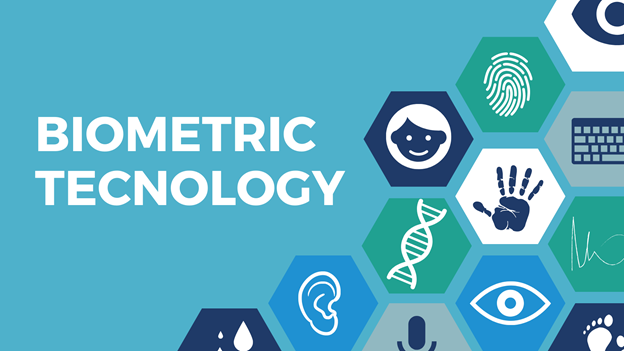What is Biometric Technology
It is the technology used to identify a person utilizing their biology. One of the first biometric technologies is Fingerprint Recognition. It is mainly used in digital forensics. Now, the technology works simply.
Modern Cybersecurity helps to reduce the risk of the weakness of traditional passwords. It answers the issue of conventional passwords.
"Biometrics" comes from the Greek word "Bio," which means life, and "Metrics" means to measure.
History of Biometric Technology
Biometrics were brought as early as the historic Babylonian empire in 626 BC. But the contemporary-day Biometrics we're acquainted with these days had been brought withinside the 1800s.
It witnessed enormous tendencies in Biometrics, consisting of the creation and the autumn of the Bertillon system, the implementation of Henry's fingerprint Classification system, and the status quo of fingerprint databases.
Major breakthroughs in Biometrics passed off withinside the 1900s, consisting of using iris styles and hand geometry for private identification. The mid-to-past due 1900s additionally noticed the delivery of the facial reputation movement.
Systems work quicker and more efficiently, social acceptance of facial recognition increases, and mobile biometric solutions have become common. Biometric technology is already secure enough to support integration at a full scale.
Types of Biometric Technology
- Biological Biometrics - Biometrics uses characteristics at the genetic and molecular levels. This may include features such as DNA or blood, which can be checked by taking a body fluid sample.
- DNA Testing - used to identify a person by analyzing DNA fragments.
2. Morphological Biometrics - uses the structure of your body to identify a person. Other physical features (such as your eyes, fingerprints, or facial shape) can be imaged for use with security scanners.
- Vein Recognition - is a biometric technology used to identify people based on the vein patterns in their fingers or palms.
- Ear Recognition - Recognize according to the shape of human ears.
- Iris Recognition - Uses the features found in the iris to recognize a person.
- Retina Recognition - uses fundus vein patterns to detect and recognize a person.
- Face Recognition - Analyze facial features or patterns to verify or recognize a person. Most facial recognition systems use self-face or local feature analysis.
- Fingerprint Recognition - Uses the ridges and valleys (details) on the tip of a person's finger to identify a person.
- Finger/Hand Geometry Recognition - Use the 3D geometry of your fingers to determine identity.
3. Behavioral Biometrics - Based on patterns unique to each person. How you walk, speak, or even type on a keyboard can indicate your identity if these patterns are tracked.
- Gait - The use of a man or woman's foot fashion or gait to decide identification.
- Typing Recognition - The use of the specific traits of a person typing for setting up identification.
- Signature Recognition - The authentication of a man or woman through the evaluation of handwriting fashion, mainly the signature. There are key sorts of virtual handwritten signature authentication, Static and Dynamic. Static is most customarily a visible evaluation among one scanned signature and every other scanned signature, or a scanned signature in opposition to an ink signature. Technology is to test scanned signatures using advanced algorithms. Dynamic is turning into greater fame as rite information is captured together with the signor's X,Y,T and P Coordinates from the signing device. This information may be utilized in a courtroom docket of regulation, the use of virtual forensic exam tools, and to create a biometric template from which dynamic signatures may be authenticated both at the time of signing or put up signing and as triggers in workflow processes.
- Voice Recognition - The use of the voice to figure out the identification of a speaker to get the right of entry to control. If the speaker claims to be of positive identification and the voice is used to affirm this claim. Speaker verification is a 1:1 fit in which one template (also called a "voiceprint" or "voice model").
Understanding the Biometric Technology
Biometric identification has a developing position in our regular security. Physical traits are exceptionally constant and individualized — even withinside the case of twins. Each person's precise biometric identification may be used to update or, as a minimum, increase password structures for computers, phones, and constrain entry to rooms and buildings. Once biometric statistics are received and mapped, it's far then stored to be matched with destiny tries to get access to. These statistics are often encrypted and saved in the tool or a remote server.
Functions of Biometric Technology
- Identification - Authenticates its customers from the biometric traits on my own without using clever cards, usernames, or ID Numbers. The biometric template is compared to all data inside the database, and the nearest suit rating is returned. The closest suit inside the allowed threshold is deemed the man or woman and authenticated.
- Verification - Authenticates its customers in conjunction, clever cards, username, or ID Number. The biometric template captured is compared to that saved towards the registered consumer both on a smart card or database for verification.
Advantages of biometric authentication
Biometric authentication and its makes use in present-day tech and virtual packages have some advantages:
- High security and assurance – Biometric identity affords the solutions to something someone has and is" and facilitates confirming identity.
- User Experience – Convenient and fast.
- Non-transferrable – Everyone has access to a unique set of Biometrics.
- Spoof-proof – Biometrics are difficult to faux or steal.
Disadvantages of biometric authentication
Despite comprehensive security, efficiency, and convenience, biometric authentication and its makes use in modern technology and virtual programs additionally have disadvantages:
- Costs – Significant investment needed in Biometrics for security.
- Data breaches – Biometric databases can nevertheless be hacked.
- Tracking and data – Biometric devices like facial recognition systems can restrict privateness for customers.
- False positives and inaccuracy – False rejects and false accepts can still occur, preventing select users from accessing structures.
Conclusion
We can see that Biometrics helps us not just for security purposes but also for the convenience of the user or a person. With the innovation that comes from technology, it makes our life more secure and convenient. Biometrics also helps us cater to the weakness found in the old way of securing our data and information.
ATGS will continue to improve our Accubooks Accounting System to incorporate this technology to provide more security, efficiency, and convenience to our users.
Start your free trial today by visiting our website https://accubooksystem.com/ and be with us to experience this technology soon.
Sources:
RecFaces. 2021. The History of Biometrics: From the 17th Century to Nowadays | RecFaces. [online] Available at: <https://recfaces.com/articles/history-of-biometrics> [Accessed 17 September 2021].
Types of Biometrics. Biometrics Institute. (2018, December 14). Retrieved September 17, 2021, from https://www.biometricsinstitute.org/what-is-biometrics/types-of-biometrics/.
"Advantages and Disadvantages of Biometrics | Mitek." Digital Identity Verification Technology & Solutions | Mitek, https://www.miteksystems.com/blog/advantages-and-disadvantages-of-biometrics.



-1748399375.png)

-1742456856.png)

 (19)-1723771883.png)
 (17)-1721953744.png)